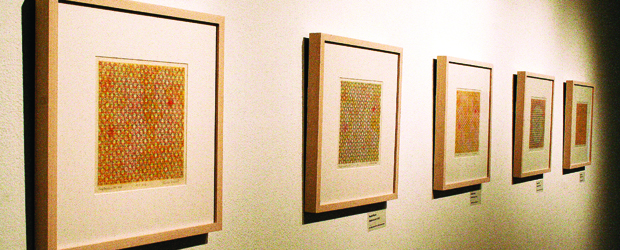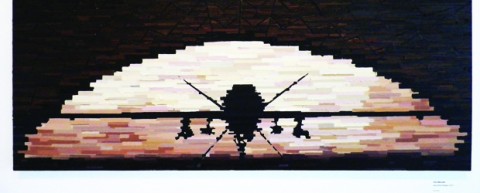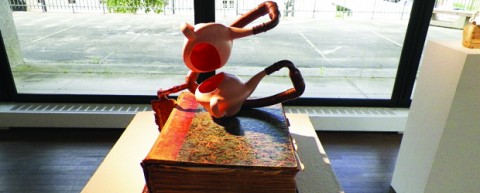On September 12, the art department hosted a reception featuring the newly-opened Faculty Art Exhibit. The exhibit, which is open to the public, displays the many talents of the contributing faculty from the art department. The exhibit includes sculptures, photography, painting, printmaking, film and drawing, demonstrating the mixed abilities of the artists. Located in Gallery 66 and Manwaring Gallery, the exhibit featured work by Professors Nadav Assor, Chris Barnard, Ted Hendrickson, Pamela Marks, Denise Pelletier, Andrea Wollensak and Sabrina Marques.
Professor Marques contributed two graphite drawings to the show. “The Bradley’s” and “Mother Theresa” display her artistic ability to capture a personal moment in time. “These drawings represent the people that were important to me at one point,” Professor Marques said. “I wanted to draw them in their domestic space.”
Her work was not alone in its “focus on memories.” Professor Wollensak provided a piece in which she shared her own childhood experiences through exploring Egill’s site near Kirkjubaejarklaustor, Iceland. This piece gives an example of a site-specific photograph where the object is somehow interacting with the environment. It also captures the area and the importance of what makes the site unique in comparison to all others.
In Professor Barnard’s two paintings, he manipulates perspective in order to observe things in different lights. “By incorporating supernatural effects of color and light, I intend to create a disorienting experience whereby the world and its contents are simultaneously right side up, upside down, and/or distorted through various filters,” he said. By giving his paintings this effect, he implies instability, ambivalence and omniscience. These inspiring pieces contribute to widening the view of the relationship between how we are positioned, how we can position ourselves and how we view the world.
Professor Assor interestingly uses a screen instead of a frame to present his fifteen-minute film entitled “Feelers (Esotropia II).” Immediately after sitting on the bench provided, one is met by unfamiliar voices telling stories about their experiences and about what they feel. The main speaker sounds like a woman who speaks of a tragic accident in the past that gives her an out of body experience, leading her to see things differently as she heals. She claims to see and feel things in people, as if she can see illness or organs “as if they speak.” The film takes place in some type of examination room where the main focus of conversation is about the patient’s life and experience. At times, the visual cuts to a translucent eye that staggers and looks in different directions while allowing the viewer to see the subjects through the reflections on its surface.
Each work of art is distinct in its own way. Some are narratives that tell stories, some raise questions and others compel the viewer to see things in a different way. When placed in the same exhibit, they allow for a refreshing experience combining aesthetically pleasing pieces with works that really make you think. This fascinating exhibit will last until late October.
Professor Hendrickson’s black and white prints depict chambers that are enclosed in the environment itself. The prints raise questions about the purpose and intentions of whoever built them. These “root cellars” are another example of capturing the landscape in time, but in this case they are just the remnants of the past. “Although frequently associated with colonial era ruins, they may have repurposed,” he said. “Some are so small, they function only symbolically as a chamber, indicating a possible ritual function. It is unclear who built them and for what purpose,” he continued. These pieces bring great wonder and curiosity to the viewer and a sense of awe for the mystery of these structures.
Professor Marks showcases five solar plate etchings all on Japanese paper, named similarly as “Displacements” numbered two to six. This abstract series contains “intricate patterns of circles layered over a contour map from U.S ‘fracking’ sites of bore holes.” she said, “These small delicate impressions on Japanese paper create unexpected optical movements and perceptual shifts while others coalesce into more static textile-like patterns.”
The illusion can be experimented with different distances, which can seduce the viewer through its intricacies and hypnotic patterns.
Not only does the exhibit display two-dimensional art, but it also showcases Professor Pelletier’s sculptures that exemplify her specialty in three-dimensional ceramics. Coming from an experience in remaking meaning and re-imagined narratives, her elegant sculptures come with a strong conceptual message and add diversity to the work in the exhibit.











